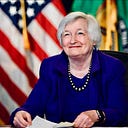Black History Month 2022
February 9, 2022
Message to Treasury Department staff for Black History Month 2022.
Last week marked the start of Black History Month, and I wanted to send along a personal reflection, especially since this is the first Black History Month where a Black woman appears on our currency.
In January, as most of you know, the Mint put Dr. Maya Angelou on the quarter. It was a poignant moment for me — seeing George Washington’s face, and on the opposite side of the coin, there was Dr. Angelou.
What does it mean to have Maya Angelou on our currency?
Well, there certainly may be some who contend it means little, that etching a new face on the money doesn’t change who has it and who doesn’t. I understand that argument, but I don’t see it that way.
In the 232 years since the Treasury Department’s founding, we’ve chosen people to appear on our currency — and they’ve almost exclusively been men — because their ideas have shaped how we run our economy: Franklin (“A penny saved is a penny earned.”), Hamilton (“A national debt will be to us a national blessing.”), Roosevelt (“We have nothing to fear but fear itself!”).
But something has been missing from this body of ideas — the intellectual contributions and remarkable achievements of Black leaders, scholars, poets, and entrepreneurs. It’s the strand of ideas that comes, in part, from being disenfranchised and persevering nonetheless, which is to say that what’s been missing is the experience of Black Americans, in general, and Maya Angelou, in particular.
Angelou, born in St. Louis, Missouri to a doorman and a nurse, had a difficult childhood, practically abandoned at times by her parents and the victim of sexual abuse. The aftermath of one of her childhood traumas left her unable to speak for five years, which is the period during which she developed her love for literature.
Her prolific career took her from winning awards at the Grammy’s to reading poetry at a presidential inauguration to performing on Broadway to helping Dr. King organize the Poor People’s March. In all her work, she mobilized language to fight for civil rights. She also knew the importance of offering a complete picture of our past.
“No man,” she wrote, “can know where he is going unless he knows exactly where he has been and exactly how he arrived at his present place.”
Thanks to the tremendous efforts the Bureau of Engraving and Printing and the Mint have undertaken to make our currency and coinage more reflective of America, we’ve chosen to incorporate that idea into how we think about running an economy; the idea that we cannot successfully do it without reckoning with our past. For all our country’s progress — both over the last year and since our founding — our economic system has failed to live up to the nation’s promise of equal opportunity for all.
Last February, I wrote about how as an economist, one of my focus areas was the racial disparity in economic outcomes — particularly after crises. I dug up some data: During the Great Recession, the highest the white unemployment rate ever reached was 9.2%, but Black unemployment reached 17% and was trapped above 10% for five years. Black unemployment also hit its peak earlier and recovered slower than unemployment for almost any other group.
“This is just what economic crises do,” I wrote, “They hit people of color harder and longer. They push our country away from our values, towards more inequality.”
When I joined Treasury just over one year ago, I knew that we had to grapple with these inequities to meet the challenges before us. As I had learned during my prior tenure in government, the first step to building more equitable policy is to recognize who has been historically left behind.
That is why we prioritized the places and people the pandemic disproportionately targeted. The efforts of this Department have been extraordinary: We ensured that we targeted aid at those who needed it most; we injected capital into Black communities; and we placed added emphasis on creating an equitable response to the economic fallout of the pandemic.
We looked inward at our Department and asked: “Where can we be more inclusive?” One way, of course, was in our own hiring, so we brought on the most diverse senior team in Treasury’s history and appointed the Department’s first Counselor for Racial Equity.
And we know that putting Dr. Angelou on the quarter is just the beginning of the work ahead to make our currency and coinage reflect the totality of the diversity of this country, including placing Harriet Tubman on the $20 bill.
None of this is enough, but it is a start, a start that I think takes the lessons of Maya Angelou and applies them to the challenges we have faced and will continue to address.
This Black History Month — the third February of the pandemic — I believe that we as a Department, and as a country, are more cognizant of where we’ve been. We know, as Maya Angelou put it, “exactly how we have arrived at our present place.” And because we know, we have influence over our destination: a fairer economy.
